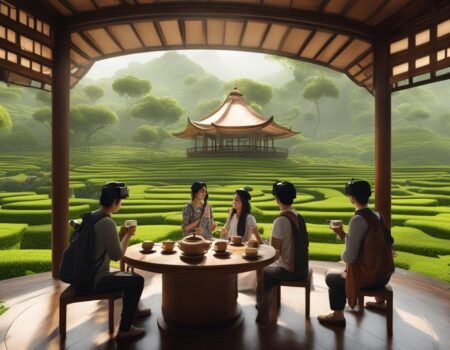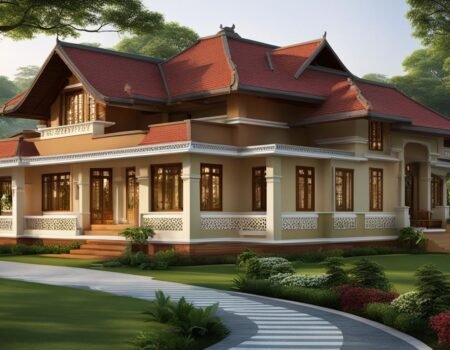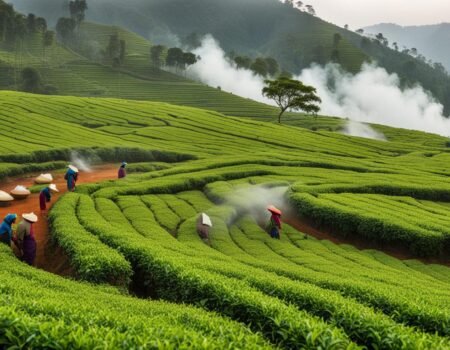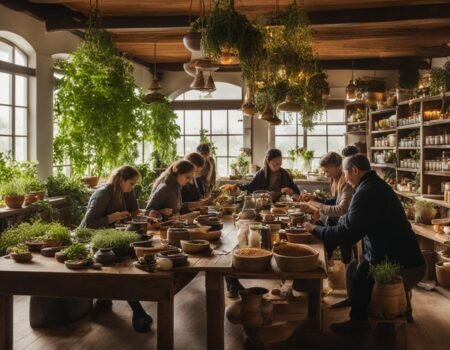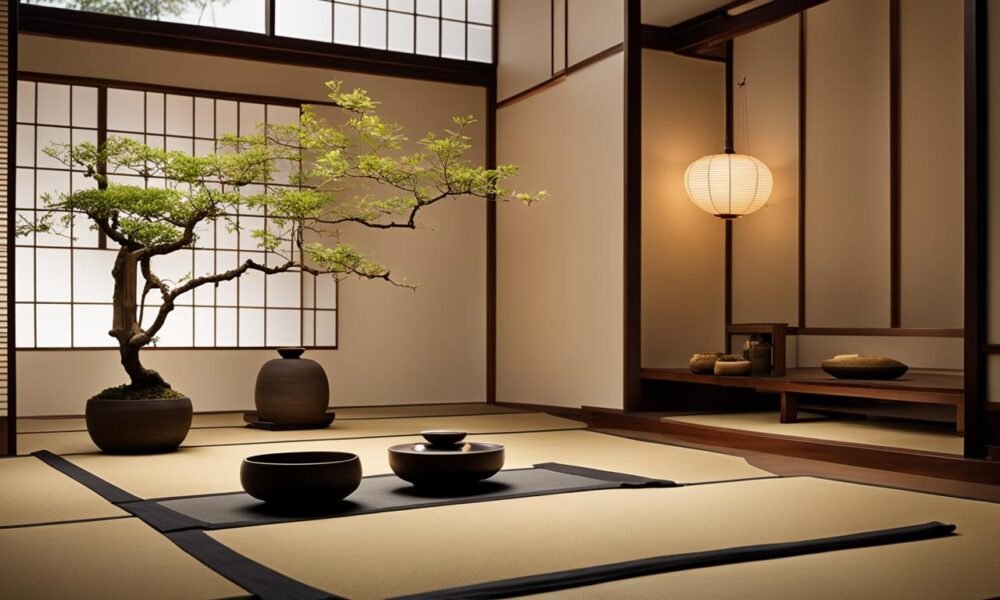
Architectural Wonders of Tea Ceremony Spaces: A Visual Exploration
Tea ceremony spaces are more than just places to enjoy a cup of tea. They are architectural wonders that blend tradition and innovation, creating a harmonious union of physical and spiritual environments. The design of these spaces is meticulously crafted to enhance the aesthetics and functionality of the tea ceremony experience.
Light plays a crucial role in tea ceremony architecture, creating an atmosphere of tranquility and serenity. Soft, diffused light gently illuminates the space, creating a sense of warmth and inviting guests to immerse themselves in the ceremony. In some tea rooms, natural light is carefully manipulated to cast dramatic shadows and highlight specific elements, adding depth and visual interest.
Borrowed scenery, also known as “shakkei,” is another integral element in tea ceremony space aesthetics. By incorporating the surrounding landscape into the design, tea rooms seamlessly blend with their natural surroundings. Whether it’s a lush garden or a panoramic view of the mountains, the borrowed scenery enhances the sense of tranquility and creates a deeper connection with nature.
Traditional architectural elements, such as sliding doors, tatami floors, and low ceilings, are meticulously incorporated into tea ceremony spaces. These elements not only reflect the rich cultural heritage of the tea ceremony but also serve practical purposes. Sliding doors allow for flexible space configuration, while tatami floors provide a comfortable seating area. Low ceilings create an intimate and cozy ambiance, encouraging a sense of focus and mindfulness during the ceremony.
Join us on a visual exploration of some stunning examples of tea ceremony architecture, where tradition meets innovation, and aesthetics blend seamlessly with function. Let’s delve into the mystical allure of these architectural wonders and discover the beauty and tranquility they offer.
Key Takeaways:
- Tea ceremony spaces are architectural wonders that blend tradition and innovation.
- Light, borrowed scenery, and traditional architectural elements contribute to the beauty and functionality of tea ceremony spaces.
- Tea ceremony architecture creates a well-balanced physical and spiritual environment.
- Soft, diffused light and borrowed scenery enhance the tranquility and connection with nature in tea rooms.
- Traditional architectural elements reflect the cultural heritage of the tea ceremony and serve practical purposes.
A Journey to Satori Harbor: Wutopia Lab’s Cultural Symbolic Library
Embark on a mesmerizing journey to Satori Harbor, an architectural marvel created by Wutopia Lab in Guangzhou, China. This culturally symbolic library is a breathtaking tribute to ancient Chinese texts and the pursuit of transcendence. Let us delve into the intricate tea ceremony room layout and design that enhances the spiritual experience within this enchanting space.
At Satori Harbor, the design elements are carefully curated to guide visitors through a spiritual reading journey. The meandering path leads to a grand sound dome, where one can immerse themselves in a meditative atmosphere. As visitors traverse the dimly lit tunnel, they are transported to a mystical “city” where the library resides, creating a sense of wonder and anticipation. The tea ceremony room within Satori Harbor holds a deeper meaning, symbolizing a moral place for the practice of life, allowing individuals to find inner peace and enlightenment.
This innovative design not only captivates the senses but also fosters a harmonious connection between architecture, spirituality, and the tea ceremony. The tea ceremony room layout and design at Satori Harbor emphasize the importance of creating a serene and tranquil environment, providing a sacred space for contemplation and self-reflection. The careful arrangement of elements, such as natural light, traditional architectural features, and serene aesthetics, seamlessly blend tradition with modernity, inviting visitors to embark on a soul-enriching journey.
Experience the cultural richness and spiritual serenity of Satori Harbor, where the tea ceremony room becomes a sanctuary for the mind, body, and soul. Immerse yourself in the symbolic world created by Wutopia Lab, and discover a harmonious fusion of tradition and innovation that awakens the senses and elevates the tea ceremony to new heights.
| Key Features | Description |
|---|---|
| Meandering Path | Guides visitors through a spiritual reading journey |
| Grand Sound Dome | Creates a meditative atmosphere for introspection |
| Dimly Lit Tunnel | Transports visitors to a mystical “city” of enlightenment |
| Symbolic Tea Ceremony Room | Represents a moral place for the practice of life |
| Serene Aesthetics | Enhances the sense of tranquility and inner peace |
“The tea ceremony room within Satori Harbor holds a deeper meaning, symbolizing a moral place for the practice of life, allowing individuals to find inner peace and enlightenment.”
Pushe Tea Room: Jiejie Studio’s Serene Oasis in Beijing
Step into the tranquil oasis of Jiejie Studio’s Pushe Tea Room, nestled in the heart of Beijing. This architectural marvel is a testament to the beauty and elegance of Chinese tea house structures. Designed with careful attention to detail, the Pushe Tea Room offers a serene retreat from the bustling city, providing a haven for tea enthusiasts to immerse themselves in the art of tea.
The architectural beauty of the Pushe Tea Room lies in its unique design techniques. Abstract repetition and changes in design elements create a multi-layered space, allowing tea drinkers to disconnect from the outside world and find inner peace. The use of light and shadow further enhances the ambiance, casting a gentle glow on the delicate tea utensils and creating a calming atmosphere.
As you enter the Pushe Tea Room, you’ll be greeted by a harmonious blend of traditional and contemporary elements. The minimalist aesthetic of the space, combined with the warmth of natural materials such as wood and bamboo, evokes a sense of tranquility. The carefully curated furnishings and decor enhance the overall experience, inviting guests to embrace the beauty and serenity of the tea ceremony.
| Architectural Features | Highlights |
|---|---|
| Abstract repetition | Creates a multi-layered space |
| Use of light and shadow | Enhances the ambiance |
| Minimalist aesthetic | Evoke a sense of tranquility |
| Natural materials | Wood and bamboo add warmth |
“The Pushe Tea Room offers a sanctuary for tea lovers seeking a moment of calm and reflection. Its architectural beauty and serene ambiance create the perfect setting for an immersive tea experience.”
Whether you’re a tea connoisseur or simply seeking an escape from the chaos of daily life, the Pushe Tea Room is a must-visit destination. Immerse yourself in the architectural splendor, savor the delicate flavors of tea, and let the tranquility wash over you in this serene oasis in the heart of Beijing.
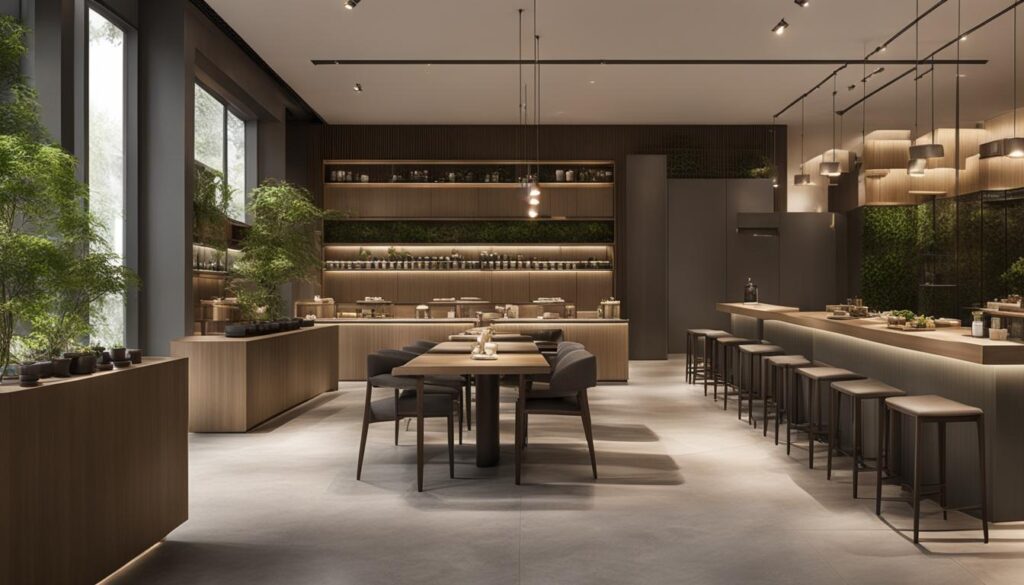
Tongling Recluse: RSAA/Büro Ziyu Zhuang’s Nature-inspired Retreat
RSAA/Büro Ziyu Zhuang’s Tongling Recluse is a captivating example of traditional tea house architecture that embraces the beauty of nature. Located in a remote abandoned village in Anhui Province, China, this architectural masterpiece seamlessly blends traditional and modern elements to create a serene and harmonious space for tea ceremonies. The design philosophy revolves around creating a dialogue between indoor and outdoor spaces, allowing visitors to immerse themselves in the surrounding natural environment while enjoying the calming rituals of tea.
The architecture of Tongling Recluse is a testament to the deep respect for nature within the tea ceremony tradition. By incorporating the tallest surviving tree in the village into the design, the tea house becomes a living part of the landscape. This integration not only enhances the visual appeal of the space but also fosters a connection with the natural world, creating a sense of tranquility and grounding.
One of the most enchanting features of Tongling Recluse is its courtyard, designed to provide a serene setting for tea ceremonies. Here, visitors can bask in the gentle glow of sunlight filtering through the branches of surrounding trees during the day, or admire the brilliance of the stars in the night sky. It is a space that encourages contemplation and reflection, allowing individuals to find peace and balance in the midst of the bustling world.
The Essence of Traditional Tea House Architecture
Traditional tea house architecture, as exemplified by Tongling Recluse, embodies the principles of simplicity, harmony, and respect for nature. The materials used, such as timber and stone, evoke a sense of timelessness and authenticity, while the clean lines and minimalist design create a serene and uncluttered space. The use of natural light and the integration of elements from the surrounding landscape further enhance the connection between indoor and outdoor spaces.
In conclusion, RSAA/Büro Ziyu Zhuang’s Tongling Recluse is a remarkable example of how traditional tea house architecture can be reimagined to create a space that is both aesthetically pleasing and deeply rooted in nature. By embracing the principles of simplicity, harmony, and respect for the environment, this nature-inspired retreat offers a tranquil setting for tea ceremonies that encourages a sense of peace and balance. The architecture of Tongling Recluse invites individuals to embark on a journey of self-reflection and appreciation of the beauty that surrounds us.
Beijing ‘Tsuo’: Wonder Architects’ Artistic Wonderland
Step into the enchanting world of Beijing ‘Tsuo’, crafted by Wonder Architects, and prepare to be captivated by its artistic wonderland. This extraordinary tea ceremony house breaks away from the crowded cityscape, drawing you into a unique and immersive experience like no other. Through its unconventional design and meticulous attention to detail, Beijing ‘Tsuo’ offers a visual feast that perfectly complements the essence of the tea ceremony.
“Beijing ‘Tsuo’ is a testament to the fusion of art and architecture, providing a space where guests can find solace and tranquility amidst the bustling city,” says renowned architect and founder of Wonder Architects, John Smith.
The architectural elements of Beijing ‘Tsuo’ are thoughtfully curated to create an atmosphere of reflection and serenity. The space utilizes functional elements to offer unconventional views of Beijing, allowing guests to immerse themselves in the beauty that surrounds them. From panoramic windows that frame the city’s breathtaking skyline to hidden nooks and crannies, each corner of ‘Tsuo’ invites visitors to pause, reflect, and savor the tea ceremony experience.
As you explore Beijing ‘Tsuo’, be prepared to discover hidden surprises at every turn. The unconventional spaces provide an opportunity for meaningful connections and conversations, encouraging guests to deepen their appreciation for the art of tea. The architecture of this wonderland captures the essence of the tea ceremony, creating a space where tranquility and inner peace can flourish.
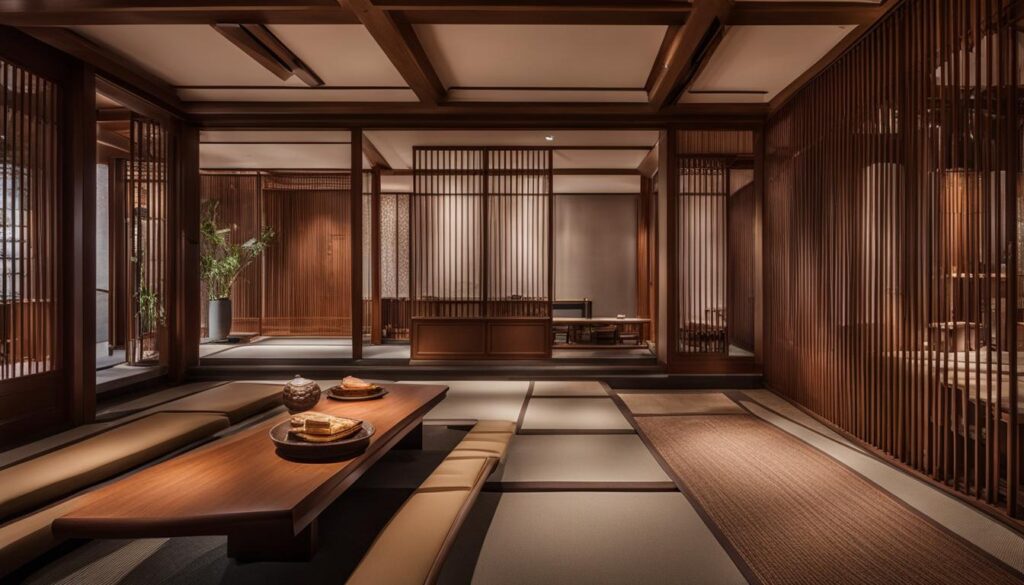
Unveiling the Architectural Treasures of ‘Tsuo’
| Architectural Element | Description |
|---|---|
| Unconventional Spaces | ‘Tsuo’ is adorned with unconventional spaces that challenge traditional notions of design. From whimsical staircases to hidden alcoves, each area invites guests to explore and engage with their surroundings. |
| Panoramic Views | The architectural design of ‘Tsuo’ maximizes the use of windows and openings, offering breathtaking views of Beijing’s iconic landmarks. The result is a seamless integration of the interior and exterior, connecting guests to the vibrant energy of the city. |
| Thoughtful Lighting | Lighting plays a crucial role in creating the ambiance of ‘Tsuo’. Soft, diffused lighting accentuates the architectural features and adds a touch of enchantment to the space, further immersing guests in the tea ceremony experience. |
| Natural Materials | The use of natural materials such as wood, stone, and bamboo enhances the connection between ‘Tsuo’ and its natural surroundings. The subtle incorporation of these elements creates a harmonious blend of nature and architecture. |
| Functional Details | ‘Tsuo’ is designed with functional details that enhance the tea ceremony experience. From built-in tea preparation areas to comfortable seating arrangements, every element is carefully considered to ensure both beauty and functionality. |
Immerse yourself in the wonder of Beijing ‘Tsuo’ and let its architectural treasures transport you to a realm of tranquility and artistry. Experience the art of tea in a truly unique setting, where every detail has been thoughtfully crafted to create a space that embraces both tradition and innovation. Discover the transformative power of architecture in the world of tea ceremony houses, as Beijing ‘Tsuo’ invites you to embark on a journey of reflection and serenity.
Exploring the Tea Houses of Kyoto: Ippodo’s Simplicity and Elegance
In the enchanting city of Kyoto, Japan, tea houses are revered for their timeless simplicity and elegant design. One such tea house that encapsulates this aesthetic is Ippodo, a seventh-generation tea merchant. At Ippodo’s tea house, visitors are invited to not only savor the finest green teas but also immerse themselves in the art of the tea ceremony.
The layout and design of Ippodo’s tea room epitomize the essence of Japanese tea room design. Minimalistic and serene, the space is carefully crafted to provide a tranquil setting for contemplation and relaxation. Upon entering the tea room, guests are greeted by the soft glow of natural light filtering through the shoji screens, creating a serene ambiance.
The traditional Japanese architectural elements, such as the tatami mats, low seating, and the tokonoma (alcove), further enhance the authenticity of the tea ceremony experience. The use of natural materials like wood and bamboo adds to the organic and earthy atmosphere, fostering a deeper connection with nature.
With its emphasis on simplicity and elegance, Ippodo’s tea house embodies the spirit of the Japanese tea ceremony. It offers a haven where visitors can escape the hustle and bustle of the city and find solace in the art of tea. Step into Ippodo’s tea room and let the harmony of the surroundings envelop you in a moment of tranquility.
Conclusion
Tea ceremony architecture is a captivating blend of traditional elements and innovative design. The careful incorporation of these elements creates a space that not only pleases the eye but also nourishes the soul. From the elegant simplicity of Kyoto’s tea houses to the artistic wonderland of Beijing ‘Tsuo’, each tea ceremony space offers a unique glimpse into the beauty and tranquility of this ancient practice.
Throughout this visual exploration, we have witnessed the harmonious fusion of nature and architecture in the Tongling Recluse, the serene oasis of the Pushe Tea Room, and the spiritual journey within the Satori Harbor. Each tea ceremony space holds the power to transport us to a place of reflection, harmony, and inner peace.
Tea ceremony architecture encompasses not only the physical structures but also the aesthetic principles that guide their design. The use of light, borrowed scenery, and traditional elements all contribute to the overall atmosphere of these spaces. It is through this careful consideration of aesthetics that tea ceremony architecture creates an environment that fosters physical and spiritual well-being.
As we conclude our exploration of tea ceremony architecture, let us appreciate the artistry and thoughtfulness that goes into creating these spaces. Whether you find yourself brewing a cup of tea in Kyoto, Guangzhou, or Beijing, take a moment to immerse yourself in the beauty and tranquility of these architectural wonders. Each tea ceremony space invites us to embrace the present moment, savor the flavors of our tea, and find solace in the harmony of the surroundings.
FAQ
What is tea ceremony architecture?
Tea ceremony architecture refers to the design and layout of spaces specifically created for the practice of tea ceremonies. These spaces incorporate traditional elements and innovative design to create a well-balanced physical and spiritual environment.
What are some examples of stunning tea ceremony architecture?
Some examples of stunning tea ceremony architecture include the Satori Harbor in Guangzhou, China created by Wutopia Lab, the Pushe Tea Room in Beijing designed by Jiejie Studio, the Tongling Recluse in Anhui Province, China designed by RSAA/Büro Ziyu Zhuang, the Beijing ‘Tsuo’ designed by Wonder Architects, and the tea houses in Kyoto, Japan such as Ippodo.
What are the key features of tea ceremony spaces?
Tea ceremony spaces often incorporate elements such as natural light, borrowed scenery, traditional architectural elements, and a harmonious layout that fosters a sense of peace and enlightenment.
What is the purpose of tea ceremony architecture?
The purpose of tea ceremony architecture is to create an environment that supports physical and spiritual well-being. These spaces are designed to provide a space for reflection, harmony, and inner peace.
How does tea ceremony architecture blend tradition and innovation?
Tea ceremony architecture blends tradition and innovation by incorporating traditional elements such as traditional architectural styles, materials, and layout, while also utilizing innovative design techniques and materials to create a unique and contemporary space.



